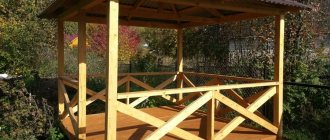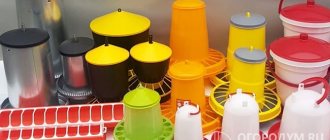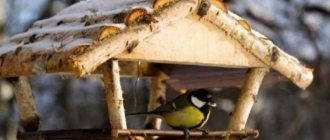Feed is one of the key factors in raising chickens. This is where most of the funds go. To properly distribute food and not lose it just like that, farmers build feeders. Of course, factory products differ in their performance, but with some skills, you can make feeders with your own hands that will be no worse than purchased ones. We’ll look at what you need for this in this article.
Choosing the right one
Poultry feeding installations are divided according to source materials:
- devices made of wood are suitable for dry feed mixtures: grains, feed, minerals, shells;
- plastic or iron feeders are useful for using wet food; they are easy to clean and do not become saturated with food;
- mesh or rods are useful when feeding fresh grass.
You can also distinguish varieties by type of feed supply:
- Tray ones work well as chicken feeders. These are peculiar containers with sides so that the food does not scatter to the sides;
- grooved with an additional limiter. Inside it can be divided into compartments for different types of feed. They are usually placed outside the cages to simplify maintenance;
- bunker feeders are mainly for dry mixtures. They are designed to be filled infrequently so that the chickens can be left for a period of time. The food remains clean and dry and is fed in doses.
The device can be placed either on the floor or suspended. The floor option is convenient if there is a need to move the feeder. The hanging container is attached to the walls from the inside or outside of the cells.
Important Details
After deciding which type of feeder is best suited, you need to move on to evaluating individual models.
When making your own feeder, such details should be taken into account even more strictly.
- Ease of maintenance. When choosing a feeder, you should evaluate its shape in advance. Easy access to all its corners must be provided, both for filling the container with food and for consumption by poultry. You should not lose sight of the need for washing - there should be no hard-to-reach places.
- Strength of materials. The fragile structure will quickly become unusable and can even injure birds. Sturdy and overly heavy feeders will be inconvenient to use: they are difficult to clean and move.
- Feed quality control. A properly chosen design will not allow chickens to scatter food, trample on it, or bring dirt and excrement into the container. Contaminated feed will harm both the health of the chickens and the quality of the products obtained from them.
- Possibility of feed dosing. When choosing a feeder, it is worth considering the number of birds. You cannot take a container that is either too large or too small: for adult chickens you need to allocate at least 10-15 centimeters of space, feeders for chickens should be selected with a minimum length of 5 centimeters per head.
- Safety. A good feeder will not have sharp corners that could injure the bird. It should not be painted or treated with any harsh chemicals.
All these nuances must be taken into account when purchasing or manufacturing, without regard to the selected configuration and type.
General requirements
To save feed, the first thing you need to pay attention to is that the chickens cannot climb into the container themselves and scatter the feed. In addition, this is necessary for its safety, so that excrement does not fall into it. You can protect the grain with sides, limiters, or by moving the container itself outside the cage.
It is also necessary to remember that the container will have to be cleaned and filled daily; the design should not create obstacles to this. In general, you need to pay attention to the weight of the container and its volume (it should be enough to feed the entire livestock for a day).
Approximately 15 centimeters of the length of the feeder are allocated per bird, which should be enough for everyone so that weaker individuals do not remain hungry. If the cage contains only chicks, you can reduce this size.
Options
We present to your attention some ideas for feeders that will turn out no worse than store-bought ones. They will be easy to use, which will significantly increase their value. At the same time, the food will not need to be replenished every time - it is enough to do it once a day.
The simplest product is considered to be a bottle hopper. To do this, you need to remove the bottom from a five-liter bottle so that 15-centimeter sides remain on it. We make a hole in it and fix it on plywood. The entire design can be slightly improved by adding one and a half liter and two-liter containers.
PVC pipes are also considered an excellent material for making feeders. For the horizontal option, you need to take a 150 mm pipe and put on the elbows on both sides - to fill the feed.
You need to make several windows in the sidewall through which the bird will feed. All that remains is to fix it on the wall. For the vertical version, we put on a tee with two elbows - but such a product is designed for a small number of chickens - take this nuance into account.
A homemade grass bunker is relatively easy to make, especially if you have the right tools. You need to select steel rods and weld and connect them using a welding machine. Then all that remains is to fix it on the wall. The proposed photos of chicken feeders will help you decide on the right one.
How to make your own feeders
Nowadays you can buy a variety of types of feeding devices, however, homemade options are quite enough for birds.
It will take very little time to make feeders with your own hands, but in financial terms the costs will decrease noticeably. To create such containers, you can use available materials: buckets, pipes, bottles, plywood and much more. Next, let's look at the possible options.
Rules for installation in a chicken coop
The basic rule for installing them is to calculate one feeder for approximately 20 birds, and the area per chicken should be approximately 15 cm. It is advisable that the edge of the feeder is at the level of the backs of the chickens.
It is better to place feed containers closer to the door in order to develop the habit of the bird returning from free range.
During disinfection periods (about twice a year), all containers (both drinking bowls and feeders) must be treated with disinfectants. And conduct monthly general washing of all equipment with detergents.
After looking at these materials, you can easily understand how to make a chicken feeder with your own hands, choose for yourself the most optimal sizes, materials, methods and methods for constructing such products.
Plastic container
The most affordable option would be bottle feeders. If the walls of the container are dense and there is a side handle, then it is quite suitable. All that needs to be done is to make a hole at a distance of about eight centimeters from the bottom so that the bird has access to food, and a slot is placed on the handle of the bottle to hang the bottle on a mesh or grate.
Types of structures by type of fastening
Here, too, you can choose one of the possible versions of the best chicken feeders for each specific case:
- Conventional floor structures, if stable, do their job quite well. They can be easily moved and rearranged to any desired place.
- Wall-mounted options are considered the most stable; they are securely attached to a wall, or to another partition, etc.
- Hanging feeders are also very convenient and popular, but are not suitable for chickens. Here, the height calculation depends on the height of the chickens.
The choice of option can sometimes be influenced by the number of livestock itself, as well as the area of the chicken coop. And some fans choose two options at once.
Hopper feeder
Hopper or automatic feeders greatly simplify the process of caring for birds. Their principle is that the feed is supplied in doses as the bird eats the previous one. You will need a bucket (wet building mixtures are usually sold in these) or, again, a large plastic bottle for water and a container, or the bottom from another bucket (the main thing is that their diameter exceeds the size of the first bucket by at least 10 centimeters).
At the bottom of the walls of the first bucket or bottle, holes are made for pouring food into the sections of the menagen. The parts are attached with screws or wire.
Simply put, a smaller diameter container with holes at the bottom is placed in a tray with sides. When the chickens eat up the food, a little more is poured from the container into the tray.
The main mistake when choosing a drinker
Out of ignorance or in order to save money, many poultry farmers serve water for chickens in ordinary open containers (saucers, lids, etc.). However, this is a serious mistake that can have negative consequences:
- water from an open container quickly evaporates; if you do not control the water supply in time, birds may experience thirst for a long time;
- There is always a risk that an open pan will tip over, leaving the chicks without water and the flooring wet. The latter factor increases the risk of developing colds and infections;
- droppings, food and flooring particles are likely to get into an open container;
- small chickens will not miss the opportunity to climb into the container. Getting wet and cold can lead to illness;
- if the vessel is too large, the chickens may even drown.
Self-made bird drinkers have a number of advantages: they are safe, protected from debris and foreign objects, and cannot be knocked over or climbed into with your feet. In many species, the water supply can be adjusted depending on the needs of the birds and the number of livestock. That is why you should give preference to a simple and effective drinking bowl, which you can make yourself using our step-by-step instructions.
Feeders made from pipes
It will require PVC pipes approximately 15 cm in diameter, plugs and a tee-splitter, the length being whatever is most convenient. Ten- and twenty-centimeter sections are separated from the pipe, and a splitter and plugs are attached to the long part. The short part is attached to the branch (this will be the tray). The structure is suspended in a cage with the long edge up. It will always be possible to temporarily close access to food.
You can arrange several such structures or modify the feeder for a large number of birds. Then the pipe needs to be cut into 2 parts, one of them 30 cm, and connected with a plastic elbow. In a short piece, using a milling attachment, two holes are poured on both sides (diameter about 4 cm), through these places the bird will peck food, the remaining edges are closed with a plug.
DIY making
Despite the wide range of ready-made products available in specialized stores for farmers and even in the hardware departments of supermarkets, many owners prefer to make their own chicken feeders. Firstly, on the farm there will always be available materials and suitable tools for the construction of a fairly simple design (plastic bottles, old buckets, basins, plywood, CD containers, scraps of PVC pipes of different diameters). Secondly, chicks grow very quickly, so spending money on buying a device that can last only a few weeks is not economically feasible, especially since the work will not take much time.
A homemade tray feeder, equipped with a barrier grid, is excellent for giving dry and wet mash to chickens up to 1.5-2 months of age
Hopper feeder made from a plastic bottle
One of the simplest and fastest to make is a feeder made from a plastic bottle with holes cut out in the bottom, installed in a food bowl, and automatically replenished as the chicks peck it. This device is suitable even for the smallest, day-old chicks.
To create it, you only need a clean plastic bottle with a volume of 1.5 or 2.0 liters (it is better if it is from mineral or purified water) and a dispensing container, which can be an enamel or aluminum bowl, a deep plate, or a round plastic box , cut off bottom of a larger plastic bottle (5-6 liters). The tools you need to prepare are scissors or a stationery knife, a glue gun, liquid nails or other neutral universal glue.
We will consider the process of making a chicken feeder from a plastic bottle at home in step-by-step instructions :
- Prepare the bottle - thoroughly wash, disinfect and dry.
- Cut off the tapered top part of the bottle (cone with stopper) to the level at which it becomes cylindrical.
- In the lower part at the bottom of the bottle, make 5-6 holes in a circle, each with a diameter of 1.5-2 cm; Melt the edges of the cuts to protect the bird from injury.
- Firmly fix the bottom of the bottle in a bowl-shaped container using any non-toxic glue or sealant, wait until it sets.
- Fill the finished bin to the top with mixed feed, cereal or grain mixture.
When distributing feed, it is very important to choose a stable round bowl to avoid the entire structure tipping over.
From such a feeder, chickens can receive food uninterruptedly throughout the day. If the diameter of the bowl is correctly calculated for the existing population, all chicks will have free access to food, even if they gather around it at the same time. And for a large number of chickens, you need to build several feeding areas and place them in the poultry house in different places.
High-quality and correctly selected practical feeders contribute to high productivity and maintenance of poultry health, and ensure rational consumption of feed.
For chickens
The same designs are made for children, but smaller containers are used for them: small buckets with a lid or 1-1.5 liter plastic bottles.
You can use a store-bought tray or use a shallow bowl instead. The manufacturing principle remains the same.
There are many more different inventions for feeding chickens. This article describes the simplest options from the available materials.
Any feeder must be kept clean and its condition monitored during use in order to avoid bird diseases and achieve its productivity.
The importance of proper feeding
Hopper feeders do not completely solve feeding problems - the feed has fallen asleep and is free . For greens, vegetables and fruits, tray-type feeders and water drinkers are required, the filling of which must be regularly monitored. For proper nutrition and development, chickens must receive minerals and vitamins in addition to the necessary proteins, fats, and carbohydrates.
For high-quality daily feeding, you can use waste from the kitchen, garden and vegetable garden: potatoes, bread, leaves and tops of vegetables, protein feed, dairy products, vegetable cakes and meal. Chickens are fed 3-4 times a day.
In the morning and evening they give grain and dry food. During the day, wet mash and greens. An amateur poultry farmer does not need to purchase expensive additives and feed. Everything you need is already on the farm to properly feed your poultry.
If you find an error, please select a piece of text and press Ctrl+Enter.
The simplest devices
You can come up with something new, but it is better to use already proven feeder ideas.
There are homemade designs that have been used for a long time and everywhere. To make them, the most accessible materials are taken: wooden boards, plastic buckets or bottles, PVC pipes, wire and other items.
It all depends on the type of product and the capabilities of the master.
The principle of operation of an automatic feeder with a timer
Automatic feeders with a timer are used only for storing and dispensing dry food. Therefore, you can pour granules, grains or mixed feed into the container. It differs from other options in that food is served in precise doses.
The principle of operation of the device is quite simple. The main part of the feed is stored in an auger, protected from the tray by a special partition. When the timer is triggered, the partition opens and loose food falls into the tray. If desired, you can make a similar option yourself using available materials.











